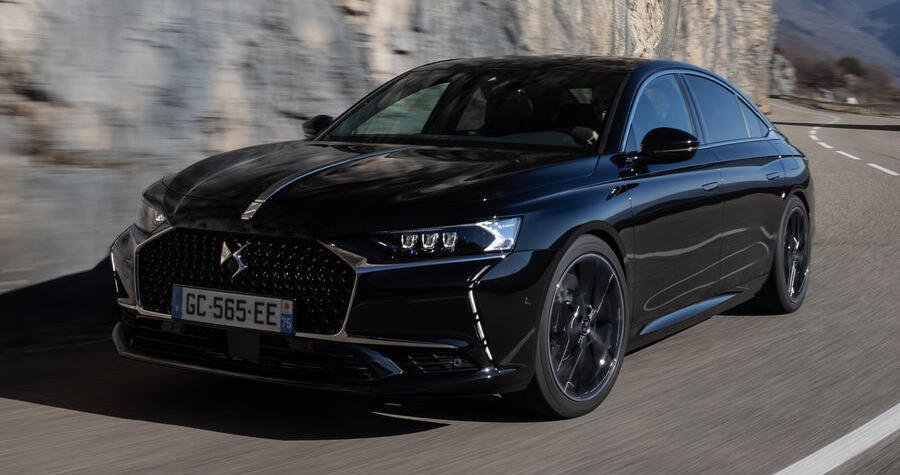DS 8 fastback to underpin brand's hopes of sales revival

The new DS 8 will be launched next year as a segment-straddling luxury flagship charged with reinvigorating the French premium brand and kickstarting its electric era.
The high-riding fastback will spearhead a totally overhauled line-up for DS, which is working to electrify each of its cars and increase its share of the market, 10 years on from its foundation as a stand-alone brand.
The new range-topper has been conceived as a replacement for today’s DS 9 saloon and will arrive at a crucial moment for the marque, which is still struggling to get a foothold in the European market.
To the end of August, sales were down 33% year on year across the region, to 26,173 cars, and fewer than 800 of those were sold in the UK.
The flagship DS 9 – based on the Peugeot 508, which is due to be pulled from sale – sold just 234 units in Europe until August this year, and only three in the UK.
Stellantis CEO Carlos Tavares has been vocal in his backing of each of the company’s 14 brands – most notably Maserati, which has been under intense scrutiny for its lacklustre financial performance.
The company is also standing by its pledge made in 2021 to give each marque 10 years of financial support before making any decisions on its future within the group.
That gives DS seven years to become more competitive in the upper mainstream segment, during which time it will also undertake a complete revamp of its product range in line with an ambition to go all-electric from 2027.
The radical new DS 8 is set to serve as a statement of intent for this new era. It helps to establish bold new design practices while introducing new powertrains and taking the brand into a new segment, in which it will compete with the likes of the Genesis GV60 and Audi Q6 E-tron.
The DS 8 will be built at Stellantis’s factory in Melfi, Italy, alongside a similarly shaped successor to the Vauxhall Insignia and Lancia’s new Gamma crossover.
Camouflaged prototypes suggest that DS is aiming to bolster its competitive credentials by ensuring that it has as broad a market reach as possible.
It will feature elements of saloon, fastback and SUV in its styling, which is not dissimilar from that of the C5 X that crowns sibling brand Citroën’s line-up.
DS is predominantly a manufacturer of crossovers (with the exception of the slow-selling 9 saloon), and the continued dominance of SUVs in the European sales charts means the brand will most likely look to retain a raised driving position and roomy cockpit for its upcoming models.
However, the forthcoming flagship 8 suggests the marque is making a departure from conventional crossover styling cues in favour of a more distinct and easily identifiable look.
The DS 8 is expected to be heavily influenced by the recently revealed DS SM Tribute. The rakish, ground-hugging saloon concept was billed as looking ahead to the brand’s future while nodding to the eponymous Citroën GT car of the 1970s.
DS design boss Thierry Métroz suggested aspects of the SM Tribute concept’s retro-futuristic design treatment will be carried over to production cars.
“We have done a transcript and reinterpretation of the SM,” he said. “But as it is not our habit to disconnect from our other work, we included a lot of details about DS Automobiles models and our future projects.”
In this context, the SM Tribute concept’s sleek, wind-cheating silhouette suggests DS will move to put aero efficiency at the centre of its design direction. It seems the brand’s relatively conventional Aero Sport Lounge SUV concept from 2020 can no longer be considered a reliable preview of the future, and DS could move away from traditionally shaped SUVs altogether.
Technically the DS 8 will be a close relation to the Peugeot 3008, Vauxhall Grandland and next-generation Citroën C5 Aircross. It will share with those models Stellantis’s new STLA Medium platform, which can accommodate hybrid, plug-in hybrid and electric powertrains.
No doubt the electric 8 – likely to be badged E-Tense – will match those cars in offering either 73kWh or 98kWh of battery capacity for a maximum range of around 435 miles, and it will be sold with a choice of single- or dual-motor powertrains, the latter packing 316bhp for hot hatch levels of performance.
Tavares has previously indicated that each of the group’s brands will take a “flexible” approach to powertrains in the run-up to going all-electric, so the 8 is also likely to be offered initially with a big-battery, 192bhp PHEV and a 48V petrol hybrid.
Inside, it is expected to follow the SM Tribute’s lead by embracing an airier and more minimalist treatment than that of the firm’s current models, with a projector display – rather than touchscreen – for the infotainment, plus extensive use of ambient lighting and upmarket materials.
Notably, the SM concept featured a yoke-controlled steer-by-wire system, which, if it makes production, could be a first for a Stellantis brand – although Peugeot has also announced plans to bring one to market.
The chief advantages of such a system are that it can be programmed easily to adapt its performance for different scenarios, it’s cheaper to produce because it requires fewer components and it frees up more packaging space for a ‘frunk’.
Full details will be revealed at the car’s unveiling, which is likely to take place by the end of the year given that 2024 is the 10th anniversary of DS operating as a stand-alone brand.
